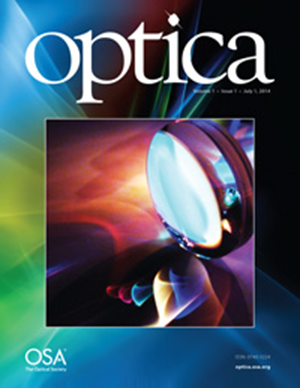Ultrafast temporal phase-resolved nonlinear optical spectroscopy in the molecular frame
IF 8.5
1区 物理与天体物理
Q1 OPTICS
引用次数: 0
Abstract
In an ultrafast nonlinear optical interaction, the electric field of the emitted nonlinear signal provides direct access to the induced nonlinear transient polarization or transient currents and thus carries signatures of ultrafast dynamics in a medium. Measurement of the electric field of such signals offers sensitive observables to track ultrafast electron dynamics in various systems. In this work, we resolve the real-time phase of the electric field of a femtosecond third-order nonlinear optical signal in the molecular frame. The electric field emitted from impulsively pre-aligned gas-phase molecules at room temperature, in a degenerate four-wave mixing scheme, is measured using a spectral interferometry technique. The nonlinear signal is measured around a rotational revival to extract its molecular-frame angle dependence from pump-probe time-delay scans. By comparing these measurements for two linear molecules, carbon dioxide and nitrogen, we show that the measured second-order phase parameter (temporal chirp) of the signal is sensitive to the valence electronic symmetry of the molecules, whereas the amplitude of the signal does not show such sensitivity. We compare measurements to theoretical calculations of the chirp observable in the molecular frame. This work is an important step towards using electric field measurements in nonlinear optical spectroscopy to study ultrafast dynamics of electronically excited molecules in the molecular frame.分子框架内的超快时间相位分辨非线性光学光谱学
在超快非线性光学相互作用中,发射的非线性信号的电场可直接获取诱导的非线性瞬态偏振或瞬态电流,从而携带介质中的超快动力学特征。对此类信号电场的测量为跟踪各种系统中的超快电子动力学提供了灵敏的观测指标。在这项工作中,我们解析了分子框架内飞秒三阶非线性光学信号电场的实时相位。我们使用光谱干涉测量技术测量了室温下冲动预对齐气相分子在退化四波混合方案中发出的电场。非线性信号围绕旋转旋转进行测量,以从泵探头时延扫描中提取其分子帧角依赖性。通过比较对二氧化碳和氮气这两种线性分子的测量结果,我们发现测量到的信号二阶相位参数(时间啁啾)对分子的价电子对称性很敏感,而信号的振幅则没有这种敏感性。我们将测量结果与分子框架中可观测到的啁啾的理论计算结果进行了比较。这项工作是利用非线性光学光谱中的电场测量来研究分子框架中电子激发分子的超快动力学的重要一步。
本文章由计算机程序翻译,如有差异,请以英文原文为准。
求助全文
约1分钟内获得全文
求助全文
来源期刊

Optica
OPTICS-
CiteScore
19.70
自引率
2.90%
发文量
191
审稿时长
2 months
期刊介绍:
Optica is an open access, online-only journal published monthly by Optica Publishing Group. It is dedicated to the rapid dissemination of high-impact peer-reviewed research in the field of optics and photonics. The journal provides a forum for theoretical or experimental, fundamental or applied research to be swiftly accessed by the international community. Optica is abstracted and indexed in Chemical Abstracts Service, Current Contents/Physical, Chemical & Earth Sciences, and Science Citation Index Expanded.
 求助内容:
求助内容: 应助结果提醒方式:
应助结果提醒方式:


